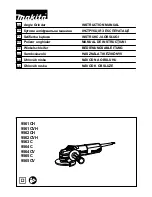
4.12 Install the 27" long steel push rods for the rudder and elevators. The rods should have been installed along with
the bulkheads when building the fuselage. If they were not, "fish" them through the holes in the bulkheads at this time,
starting at the rear of the plane. They should go through the set of bulkhead holes closest to the bottom of the fuselage,
with the threaded end of the rods at the rear of the plane.
BE SURE AND HA VE AN EXPERIENCED MODELER INSPECT
YOUR CONTROL ROD LINKAGES TO MAKE SURE THEY ARE
SAFELY CONNECTED. LOSS OF ONE OF THESE CONNECTIONS
DURING FLIGHT COULD BE EXTREMELY HAZARDOUS.
INSPECT THEM FREQUENTL BETWEEN FLIGHTS.
ADJUSTABLE
"E-Z" TYPE
CONNECTOR
FUEL TUBING
SAFETY KEEPER
(CHECK FREQUENTL )
SERVO HORN
(END VIEW)
"Z-BEND' METHOD
(USE "Z-BEND-TOOL)
CLEVIS
.078 STEEL
PUSH ROD
THREADED
END HERE
FIGURE 29 - INSTALLING CONTROL RODS
Slip a 1/4" long piece of fuel tubing over the threaded end of each rod and install a clevis. The tubing will be used as a
safety keeper on the clevis. Install (twist) the clevis onto the threads of the rod. Next connect the clevis to the horn, using
a middle hole (3 holes up from the base) on the horn for the connection. Slide the fuel tubing over the clevis as a safety
keeper (check it frequently for wear).
With the elevator and rudder in the neutral position, measure and mark where the rod will connect to the servo. Use either a
"7" bend, "EZ connector" or some other type of connector to connect the rod to your servo arm and cut off any excess rod.
BE SURE TO HAVE AN EXPERIENCED MODELER INSPECT YOUR CONTROL ROD LINKAGES TO MAKE SURE THEY ARE SAFELY CONNECTED. LOSS
OF ONE OF THESE CONNECTIONS DURING FLIGHT COULD BE EXTREMELY HAZARDOUS. INSPECT THEM FREQUENTLY BETWEEN FLIGHTS.
4.13 Alignment of wing and stab. Reattach your wing and examine the aircraft from the rear and front, paying attention
to the horizontal alignment of the wing and the stab. Both should be on the same horizontal "plane" and in alignment. If
they are not, it may be necessary to either trim the wing saddle slightly with a sharp hobby knife or add some scrap 2-mil
material to the wing wrap where the wing meets the wing saddle to lower the side that is too high.
4.14 Wing Positioning Strips. We like to add 1/2" wide strips of 2mil AirCore material on top of the wing wrap just
outside each side of the fuselage to serve as guides when installing the wing. These also keep the wing from slipping in
the wing saddle during rough landings or high-G maneuvers.
First attach the wing to the fuselage, making sure it is centered on the fuse. Measure from each wing tip to the tail to make
certain the wing is squarely mounted. Once done, use a ball point pen and mark lines on the wing wrap where the fuselage
meets the wing wrap.
Remove the wing and glue 1/2" wide strips of 2-mil AirCore on and outside the lines you have drawn using contact cement.
From now on, you will always mount the wing squarely between these two alignment strips!
23






































